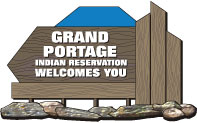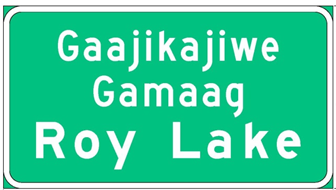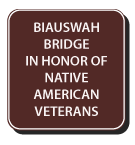Tribal Signing Programs
Guide and service sign programs
Information on the design and placement of signs on state highways at and within the boundaries of reservations located throughout Minnesota.
- Tribes and Transportation website
- Administered by MnDOT district traffic offices.
- Some of the signing programs are based on federal guidelines.
- Many of these signs allow the display of text, logos or pictographs as appropriate, that may be unique to each reservation.
- References to state statutes that specify additional signing program specifics are included.
- The casino signing program is the result of consulting with the tribes on MnDOT's Casino Signing Policy guidelines.
- Reservation Road Signs brochure (PDF)
Questions on the signing programs should be directed to the MnDOT District Traffic Engineer.
This does not cover standard signs such as speed limit (regulatory) and chevron (warning) signs. For the safety of the road user, the usage and placement of standard signs needs to be in accordance with the Minnesota Manual on Uniform Traffic Control Devices (MN MUTCD) and MnDOT's Traffic Engineering Manual (TEM).
Dakota and Ojibwe language signing program
- Sign size variable based on MnDOT sign design standards
- May be installed on conventional road trunk highways
- Requests may include boundary (city, county and reservation) and geographic feature (lakes, rivers) signs
- The language legend is either Dakota or Ojibwe and is the idiomatic equivalent of the English legend
- Ref. MnDOT Traffic Engineering Manual Ch. 6
Community identification signs

- Sign size: 750 square feet maximum
- Sign to be installed outside trunk highway right of way
- No advertising allowed on sign
- Must be located within two miles of community
- Must obtain approval of governing body of community
- Community must consult with road authority on sign placement and location
- Community must obtain consent of land owner on which sign is to be erected
- Community fabricates, installs and maintains
- Paid for by community
- Ref. MnDOT Traffic Engineering Manual Ch. 6
- Ref. Minnesota Statute 173.08, subd. 1(10)
Reservation boundary signs

- Sign size: variable based on sign message and font sizes
- May be located at Federally recognized reservation boundaries
crossing trunk highways, except freeways - May include pictograph and year of treaty or population on sign
panel - Sign panel design to be approved by MnDOT prior to fabrication
- Ref. MnDOT Traffic Engineering Manual Ch. 6
Community recognition signs (panels)

- Sign size: typical 2' x 2', maximum 12 square feet (6 feet long x 2 feet high)
- May be installed on reservation boundary sign structures
- May be installed on city population sign structures with city consent
- May be installed only on two lane two way trunk highways in Metro area
- May be installed on trunk highways, excluding interstate highways, in Greater Minnesota (79 counties)
- Community fabricates, installs and maintains under MnDOT permit process
- Paid for by community
- Ref. MnDOT Traffic Engineering Manual Ch. 6
- Ref. Minnesota Statute 173.08, subd. 1(10)
Casino signing

- Sign size variable based on MnDOT sign design standards
- May be installed on trunk highways
- Fabricated, installed and maintained by MnDOT or under contract
- Paid for by casino
- Ref. MnDOT Traffic Engineering Manual Ch.6
Educational institution signing (postsecondary schools)

- Sign size: variable based on MnDOT sign design standards
- May be installed on trunk highways
- Fabricated, installed and maintained by MnDOT or under contract
- Paid for by educational institution
- Ref. MnDOT Traffic Engineering Manual Ch.6
Treaty boundary signs

- Sign size: variable depending on roadway type
- Sign will be placed at the approximate location of the treaty boundary
- Paid for by the requesting agency
- Ref. MnDOT Traffic Engineering Manual Ch.6








